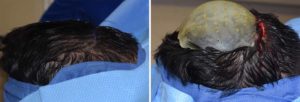There are over fifteen types of aesthetic skull deformities. But the most common amongst them is various forms of flattening of the back of head. Perhaps because the back of head is exposed to various pressures in utero and after birth more than any other area of the head, it is prone to deformational pressures that can cause its shape to be flatter. This flatness can affect just one (plagiocephaly), both sides (brachycephaly) or even subtotal portions of either side.
The most effective treatment for flat back of the heads, regardless of its size, is a custom occipital skull implant. Made from the patient’s 3D CT scan, the implant design can be made to cover all flat areas and match any asymmetries between the right and left sides. The flexibility of a silicone implant allows the precisely-designed implant to be inserted through the smallest possible scalp incision usually placed at the mid-portion of the occipital scalp.

Recovery from skull implant surgery is fairly quick. One can expect some swelling and bruising in the temporal areas on the sides where the implant is primarily placed. This is to be expected due to the subperiosteal dissection needed to make the implant pocket. Since the dissection is done under general anesthesia in the prone position, combined with effects of gravity, such tissue fluids work their way towards the face. The facial swelling and bruising resolves by ten days after the surgery.
Dr. Barry Eppley
Indianapolis, Indiana


